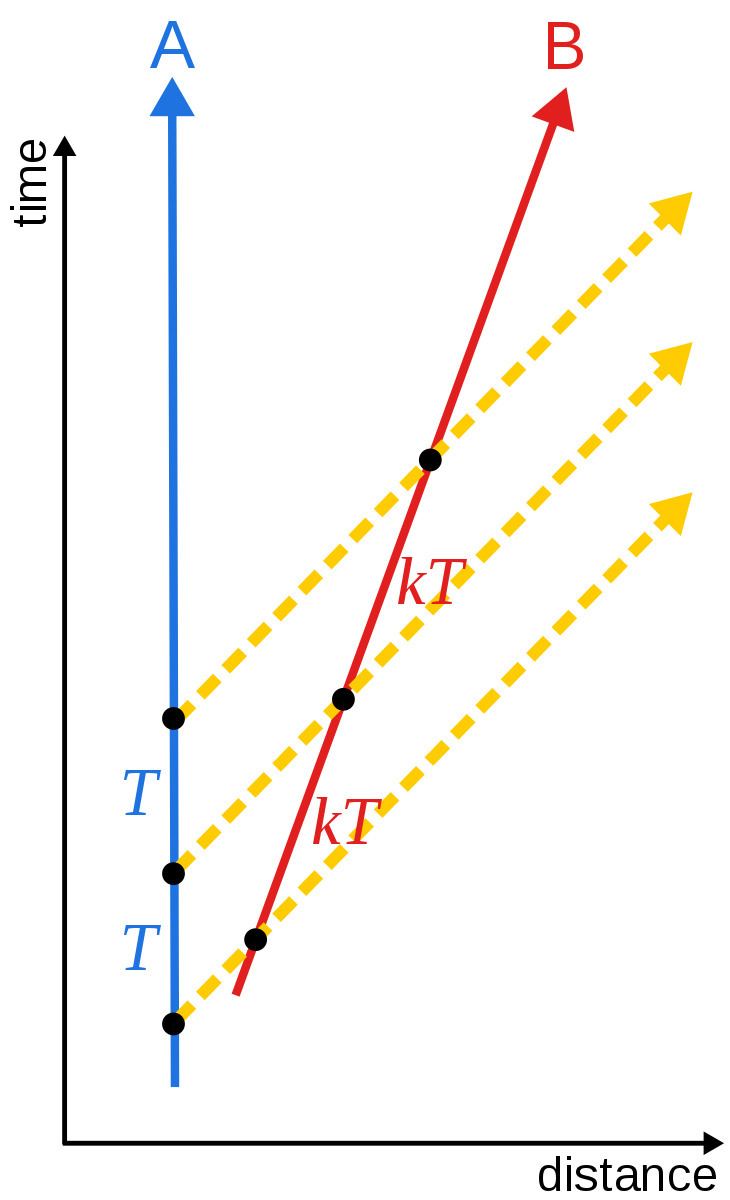 | ||
Bondi k-calculus is a method of teaching special relativity popularised by Professor Sir Hermann Bondi, and now common in university and college-level physics classes.
Contents
- History
- Bondis k factor
- The reciprocal k factor
- The twins paradox
- Radar measurements and velocity
- Velocity composition
- The invariant interval
- The Lorentz transformation
- Rapidity
- References
The usefulness of the k-calculus is its simplicity. It has been successfully used to teach special relativity to young children and also in relativity textbooks.
Many introductions to relativity begin with the concept of velocity and a derivation of the Lorentz transformation. Other concepts such as time dilation, length contraction, the relativity of simultaneity, the resolution of the twins paradox and the relativistic Doppler effect are then derived from the Lorentz transformation, all as functions of velocity.
Bondi, in his book Relativity and Common Sense, first published in 1964 and based on articles published in The Illustrated London News in 1962, reverses the order of presentation. He begins with what he calls "a fundamental ratio" denoted by the letter
History
The k-calculus method had previously been used by E. A. Milne in 1935. Milne used the letter
Bondi's k-factor
Consider two inertial observers, Alice and Bob, moving directly away from each other at constant relative velocity. Alice sends a flash of blue light towards Bob once every
Bondi describes
Alice's flashes are transmitted at a frequency of
If Alice and Bob were to swap roles, and Bob sent flashes of light to Alice, the Principle of Relativity (Einstein's first postulate) implies that the k-factor from Bob to Alice would be the same value as the k-factor from Alice to Bob, as all inertial observers are equivalent. So the k-factor depends only on the relative speed between the observers and nothing else.
The reciprocal k-factor
Consider, now, a third inertial observer Dave who is a fixed distance from Alice, and such that Bob lies on the straight line between Alice and Dave. As Alice and Dave are mutually at rest, the delay from Alice to Dave is constant. This means that Dave receives Alice's blue flashes at a rate of once every
Now suppose that whenever Bob receives a blue flash from Alice he immediately sends his own red flash towards Dave, once every
This establishes that the k-factor for observers moving directly apart (red shift) is the reciprocal of the k-factor for observers moving directly towards each other at the same speed (blue shift).
The twins paradox
Consider, now, a fourth inertial observer Carol who travels from Dave to Alice at exactly the same speed as Bob travels from Alice to Dave. Carol's journey is timed such that she leaves Dave at exactly the same time as Bob arrives. Denote times recorded by Alice's, Bob's and Carol's clocks by
When Bob passes Alice, they both synchronise their clocks to
If Alice sends a flash of light at time
Also, when Bob and Carol meet, they both simultaneously send flashes to Alice, which are received simultaneously by Alice. Considering, first, Bob's flash, sent at time
As Bob's outward journey had a duration of
provided
Radar measurements and velocity
In the k-calculus methodology, distances are measured using radar. An observer sends a radar pulse towards a target and receives an echo from it. The radar pulse (which travels at
Furthermore, since the speed of light is the same in both directions, the time at which the radar pulse arrives at the target must be, according to the observer, halfway between the transmission and reception times, namely
In the particular case where the radar observer is Alice and the target is Bob (momentarily co-located with Dave) as described previously, by k-calculus we have
As Alice and Bob were co-located at
This equation expresses velocity as a function of the Bondi k-factor. It can be solved for
Velocity composition
Consider three inertial observers Alice, Bob and Ed, arranged in that order and moving at different speeds along the same straight line. In this section, the notation
As before, Alice sends a blue flash towards Bob and Ed every
Now suppose that whenever Bob receives a blue flash from Alice he immediately sends his own red flash towards Ed, once every
Finally, substituting
gives the velocity composition formula
The invariant interval
Using the radar method described previously, inertial observer Alice assigns coordinates
Similarly, inertial observer Bob can assign coordinates
Now, applying the k-calculus method to the signal that travels from Alice to Bob
Similarly, applying the k-calculus method to the signal that travels from Bob to Alice
Equating the two expressions for
This establishes that the quantity
The Lorentz transformation
The two equations for
These equations are the Lorentz transformation expressed in terms of the Bondi k-factor instead of in terms of velocity. By substituting
the more traditional form
is obtained.
Rapidity
Rapidity
and so
The k-factor version of the Lorentz transform becomes
It follows from the composition rule for
